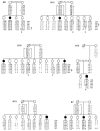A founder effect in the newfoundland population reduces the Bardet-Biedl syndrome I (BBS1) interval to 1 cM
- PMID: 10577922
- PMCID: PMC1288379
- DOI: 10.1086/302686
A founder effect in the newfoundland population reduces the Bardet-Biedl syndrome I (BBS1) interval to 1 cM
Abstract
Bardet-Biedl syndrome (BBS) is a rare, autosomal recessive disorder; major phenotypic findings include dysmorphic extremities, retinal dystrophy, obesity, male hypogenitalism, and renal anomalies. In the majority of northern European families with BBS, the syndrome is linked to a 26-cM region on chromosome 11q13. However, the finding, so far, of five distinct BBS loci (BBS1, 1q; BBS2, 16q; BBS3, 3p; BBS4, 15q; BBS5, 2q) has hampered the positional cloning of these genes. We use linkage disequilibrium (LD) mapping in an isolated founder population in Newfoundland to significantly reduce the BBS1 critical region. Extensive haplotyping in several unrelated BBS families of English descent revealed that the affected members were homozygous for overlapping portions of a rare, disease-associated ancestral haplotype on chromosome 11q13. The LD data suggest that the BBS1 gene lies in a 1-Mb, sequence-ready region on chromosome 11q13, which should enable its identification.
Figures



References
Electronic-Database Information
-
- Online Mendelian Inheritance in Man (OMIM), http://www.ncbi.nlm.nih.gov/Omim (for BBS [MIM 209900])
-
- Sixth International SCW 11 Workshop (Nice, France, 1998), http://www.genetics.wustl.edu/gerhard/SCW11/SCW11.html
References
-
- Bear JC, Nemec TF, Kennedy JC, Marshall WH, Power AA, Kolonel VM, Burke GB (1988) Inbreeding in outport Newfoundland. Am J Med Genet 29:649–660 - PubMed
-
- Bruford EA, Riise R, Teague PW, Porter K, Thomson KL, Moore AT, Jay M, et al (1997) Linkage mapping in 29 Bardet-Biedl syndrome families confirms loci in chromosomal regions 11q13, 15q22.3-q23, and 16q21. Genomics 41:93–99 - PubMed
-
- Carmi R, Rokhlina T, Kwitek-Black AE, Elbedour K, Nishimura D, Stone EM, Sheffield VC (1995) Use of a DNA pooling strategy to identify a human obesity syndrome locus on chromosome 15. Hum Mol Genet 4:9–13 - PubMed
-
- Cooper PR, Nowak NJ, Higgins MJ, Simpson SA, Marquardt A, Stoehr H, Weber BHF, et al (1997) A sequence-ready high resolution physical map of the Best macular dystrophy gene region in 11q13. Genomics 41:185–192 - PubMed
Publication types
MeSH terms
Substances
LinkOut - more resources
Full Text Sources
Other Literature Sources
Molecular Biology Databases
Research Materials
Miscellaneous

